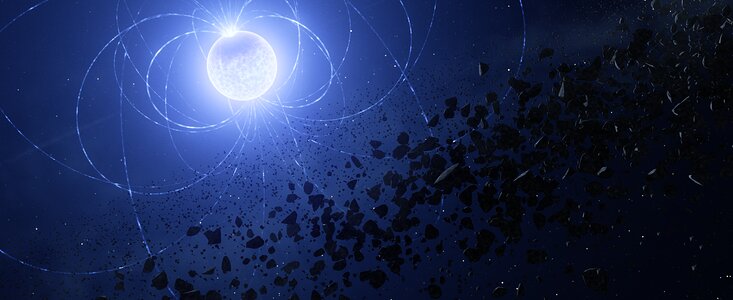Press Release
Metal scar found on cannibal star
26 February 2024
When a star like our Sun reaches the end of its life, it can ingest the surrounding planets and asteroids that were born with it. Now, using the European Southern Observatory’s Very Large Telescope (ESO’s VLT) in Chile, researchers have found a unique signature of this process for the first time — a scar imprinted on the surface of a white dwarf star. The results are published today in The Astrophysical Journal Letters.
“It is well known that some white dwarfs — slowly cooling embers of stars like our Sun — are cannibalising pieces of their planetary systems. Now we have discovered that the star’s magnetic field plays a key role in this process, resulting in a scar on the white dwarf’s surface,” says Stefano Bagnulo, an astronomer at Armagh Observatory and Planetarium in Northern Ireland, UK, and lead author of the study.
The scar the team observed is a concentration of metals imprinted on the surface of the white dwarf WD 0816-310, the Earth-sized remnant of a star similar to, but somewhat more massive than, our Sun. “We have demonstrated that these metals originate from a planetary fragment as large as or possibly larger than Vesta, which is about 500 kilometres across and the second-largest asteroid in the Solar System,” says Jay Farihi, a professor at University College London, UK, and co-author on the study.
The observations also provided clues to how the star got its metal scar. The team noticed that the strength of the metal detection changed as the star rotated, suggesting that the metals are concentrated on a specific area on the white dwarf’s surface, rather than smoothly spread across it. They also found that these changes were synchronised with changes in the white dwarf’s magnetic field, indicating that this metal scar is located on one of its magnetic poles. Put together, these clues indicate that the magnetic field funneled metals onto the star, creating the scar [1].
“Surprisingly, the material was not evenly mixed over the surface of the star, as predicted by theory. Instead, this scar is a concentrated patch of planetary material, held in place by the same magnetic field that has guided the infalling fragments,” says co-author John Landstreet, a professor at Western University, Canada, who is also affiliated with the Armagh Observatory and Planetarium. “Nothing like this has been seen before.”
To reach these conclusions, the team used a ‘Swiss-army knife’ instrument on the VLT called FORS2, which allowed them to detect the metal scar and connect it to the star’s magnetic field. “ESO has the unique combination of capabilities needed to observe faint objects such as white dwarfs, and sensitively measure stellar magnetic fields,” says Bagnulo. In their study, the team also relied on archival data from the VLT’s X-shooter instrument to confirm their findings.
Harnessing the power of observations like these, astronomers can reveal the bulk composition of exoplanets, planets orbiting other stars outside the Solar System. This unique study also shows how planetary systems can remain dynamically active, even after 'death'.
Notes
[1] Previously, astronomers have observed numerous white dwarfs polluted by metals that were scattered over the surface of the star. These are known to originate from disrupted planets or asteroids that veer too close to the star, following star-grazing orbits similar to those of comets in our Solar System. However, for WD 0816-310, the team is confident that vaporised material was ionised and guided onto the magnetic poles by the white dwarf's magnetic field. The process shares similarities to how auroras form on Earth and on Jupiter.
More information
This research was presented in a paper titled “Discovery of magnetically guided metal accretion onto a polluted white dwarf” to appear in The Astrophysical Journal Letters (doi:10.3847/2041-8213/ad2619).
The team is composed of Stefano Bagnulo (Armagh Observatory & Planetarium, UK [Armagh]), Jay Farihi (Department of Physics and Astronomy, University College London, UK), John D. Landstreet (Armagh; Department of Physics & Astronomy, Western University, Canada), and Colin P. Folsom (Tartu Observatory, University of Tartu, Estonia).
The European Southern Observatory (ESO) enables scientists worldwide to discover the secrets of the Universe for the benefit of all. We design, build and operate world-class observatories on the ground — which astronomers use to tackle exciting questions and spread the fascination of astronomy — and promote international collaboration for astronomy. Established as an intergovernmental organisation in 1962, today ESO is supported by 16 Member States (Austria, Belgium, Czechia, Denmark, France, Finland, Germany, Ireland, Italy, the Netherlands, Poland, Portugal, Spain, Sweden, Switzerland and the United Kingdom), along with the host state of Chile and with Australia as a Strategic Partner. ESO’s headquarters and its visitor centre and planetarium, the ESO Supernova, are located close to Munich in Germany, while the Chilean Atacama Desert, a marvellous place with unique conditions to observe the sky, hosts our telescopes. ESO operates three observing sites: La Silla, Paranal and Chajnantor. At Paranal, ESO operates the Very Large Telescope and its Very Large Telescope Interferometer, as well as survey telescopes such as VISTA. Also at Paranal ESO will host and operate the Cherenkov Telescope Array South, the world’s largest and most sensitive gamma-ray observatory. Together with international partners, ESO operates ALMA on Chajnantor, a facility that observes the skies in the millimetre and submillimetre range. At Cerro Armazones, near Paranal, we are building “the world’s biggest eye on the sky” — ESO’s Extremely Large Telescope. From our offices in Santiago, Chile we support our operations in the country and engage with Chilean partners and society.
Links
- Research paper
- Photos of the VLT
- For journalists: subscribe to receive our releases under embargo in your language
- For scientists: got a story? Pitch your research
Contacts
Stefano Bagnulo
Armagh Observatory and Planetarium
Armagh, UK
Tel: +44 (0)28 3752 3689
Email: Stefano.Bagnulo@Armagh.ac.uk
Jay Farihi
Department of Physics & Astronomy, University College London
London, UK
Email: j.farihi@ucl.ac.uk
John Landstreet
Department of Physics & Astronomy, University of Western Ontario and Armagh Observatory and Planetarium
London and Armagh, Canada and UK
Email: jlandstr@uwo.ca
Bárbara Ferreira
ESO Media Manager
Garching bei München, Germany
Tel: +49 89 3200 6670
Cell: +49 151 241 664 00
Email: press@eso.org
About the Release
| Release No.: | eso2403 |
| Name: | WD 0816-310 |
| Type: | Milky Way : Star : Evolutionary Stage : White Dwarf |
| Facility: | Very Large Telescope |
| Instruments: | FORS2, X-shooter |
| Science data: | 2024ApJ...963L..22B |



